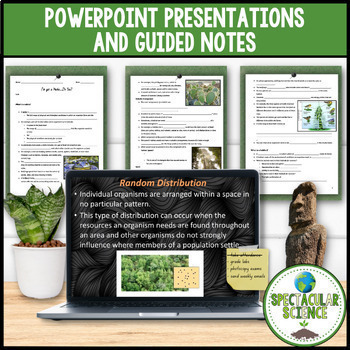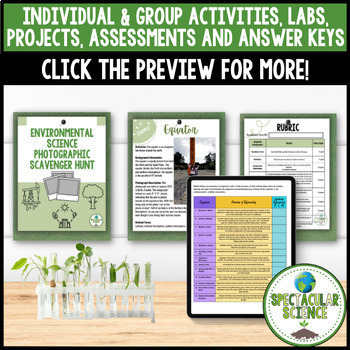Environmental Science Curriculum Bundle
- Zip
What educators are saying
Products in this Bundle (78)
showing 1-5 of 78 products
Bonus
Description
Environmental Science is a laboratory course that is designed to help students understand the complex nature of our environment and make responsible decisions regarding its protection and use. Students will be introduced to problems of land use, human population, environmental health, and sustainability. Field studies and inquiry-based investigations are an integral part of this course.
This curriculum is aligned to the Next Generation Science Standards and offers a treasure trove of teaching materials and tools, including:
- Editable Lesson Plans: Tailor your teaching to your students' needs.
- PowerPoint Presentations: Engage and captivate with stunning visuals.
- Guided Notes: Keep students on track and actively learning.
- Engaging Activities: Make learning fun and hands-on.
- Virtual Field Trips: Journey through space and time without leaving the classroom.
- Inspiring Projects: Encourage creativity and critical thinking.
- Fascinating Labs: Dive into experiments that breathe life into science.
- Comprehensive Assessments and Answer Keys: Easily track progress and success.
But that's not all – this bundle is dynamic and growing. As new resources emerge, you'll gain access to them at no extra cost!
✎ WHY PUCHASE A YEARLONG BUNDLE?
✅ Comprehensive Coverage: A yearlong curriculum bundle is designed to cover all essential topics within the Earth and Space Science subject, ensuring that your students receive a well-rounded education.
✅ Time Savings: Creating a curriculum from scratch can be time-consuming and challenging. A curriculum bundle saves you time by providing ready-made lesson plans, assessments, and teaching resources, allowing you to focus on teaching rather than extensive planning and resource development.
✅ Consistency and Alignment: This bundle is aligned to the NGSS standards, ensuring that you are teaching all of the vital skills required in this course.
✅ Varied Resources: This curriculum bundle includes a range of teaching materials, such as worksheets, videos, experiments, and interactive activities. This variety helps you cater to different learning styles and engage your students effectively
✎ WHAT'S INCLUDED?
There are over 75 resources and 2600+ pages of material included in this comprehensive unit, but don't worry! You'll also get a handy curriculum map and pacing guides specifically designed to support you every step of the way. These units are neatly organized into the following categories:
- Introduction to Environmental Science
- Land Usage, Environmental Economics & Policy
- Humans and the Environment
- Toward a Sustainable Future
- Ecology
► Note: After purchasing this bundle, navigate to the very last file entitled "BONUS - Environmental Science Curriculum Bundle" to gain access to the entire curriculum on your google drive. Here you will also find some freebies waiting for you!
⭐ Looking for quality resources and time-saving tips for your secondary science classroom?
☑ Follow Spectacular Science on TPT
☑ Subscribe to My Newsletter
☑ Check Out My Blog
☑ Follow Me on Instagram





